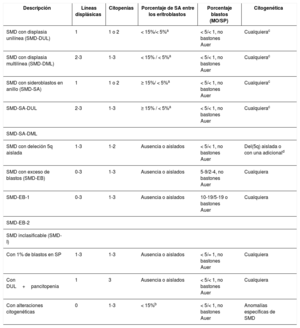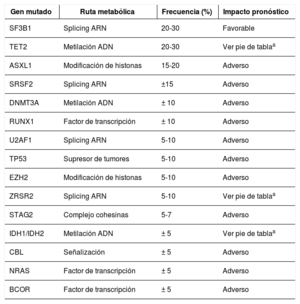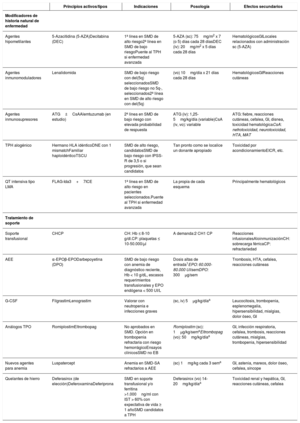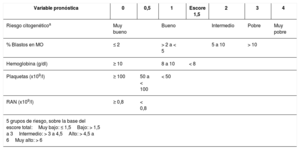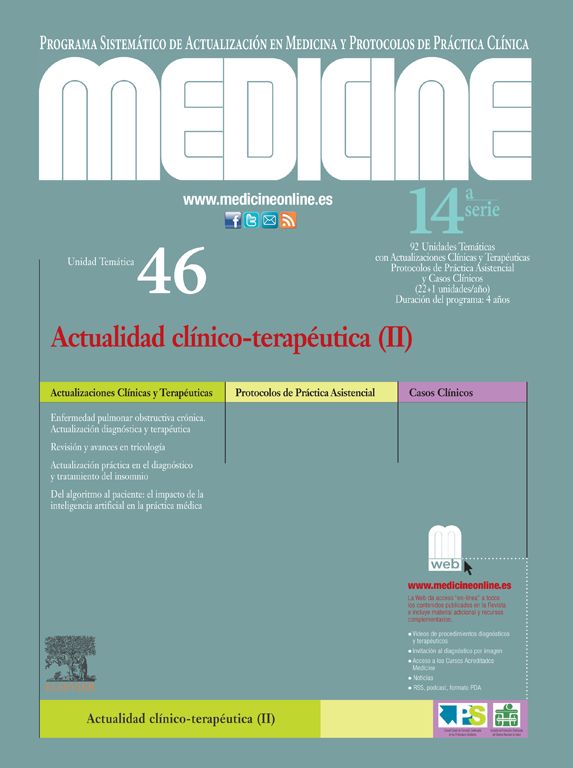Los síndromes mielodisplásicos son enfermedades clonales de la célula madre hematopoyética propias de personas mayores, que se caracterizan por presentar insuficiencia medular, evidenciada principalmente por citopenias, y riesgo aumentado de evolución a leucemia aguda mieloblástica. El diagnóstico pasa por descartar causas secundarias y caracterizar y cuantificar la displasia en las tres series hematopoyéticas, así como la proporción de mieloblastos, tanto en sangre periférica como en médula ósea. Cada vez cobra más importancia el papel diagnóstico y pronóstico de las alteraciones cariotípicas y genéticas propias de estos síndromes, tanto que en los últimos años han entrado a formar parte de los criterios diagnósticos e índices pronósticos más empleados. Aunque existen tratamientos de gran eficacia, la mayor parte de los pacientes serán mayores y presentarán una comorbilidad suficiente como para impedir optar por un manejo agresivo y, por tanto, curativo. En este escenario es esencial la correcta estratificación del riesgo de la enfermedad, siempre teniendo en cuenta la situación basal del individuo. Además, es importante promover la inclusión de los pacientes en ensayos clínicos, sobre todo en subgrupos de peor pronóstico, pues aún hay un amplio margen de mejora terapéutica.
Palabras clave
Myelodysplastic syndromes are clonal diseases of the hematopoietic stem cells more commonly found in the elderly. They are characterized by bone marrow failure, mainly observed through cytopenia, and an increased risk of progression to acute myeloid leukemia. A diagnosis is made by ruling out secondary causes and characterizing and quantifying the dysplasia in three hematopoietic series as well as the proportion of myeloblasts both in peripheral blood and in bone marrow. The diagnostic and prognostic role of the karyotypic and genetic abnormalities inherent to these syndromes is gaining importance, so much so that in recent years, they have been added to the most used commonly diagnostic criteria and prognostic indices. Although highly effective treatments exist, the majority of patients are older and present with sufficient comorbidity so as to prevent choosing aggressive, and therefore curative, treatment. In this scenario, correct risk stratification of the disease is essential, always taking into account the individual's baseline condition. In addition, it's important to promote the inclusion of patients in clinical trials, especially in the subgroups of patients with worse prognoses, as there is still a wide margin for therapeutic improvement.
Keywords
Identifíquese
¿Aún no es suscriptor de la revista?
Comprar el acceso al artículo
Comprando el artículo el pdf del mismo podrá ser descargado
Teléfono para incidencias
De lunes a viernes de 9h a 18h (GMT+1) excepto los meses de julio y agosto que será de 9 a 15h





